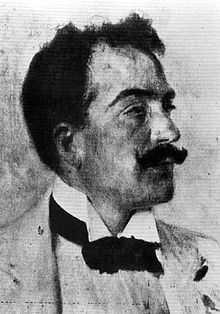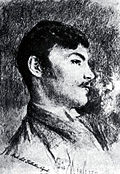- Mese mariano
-
Umberto Giordano  Operas
Operas- Andrea Chénier (1896)
- Fedora (1898)
- Mese mariano (1910)
- Siberia (1903, rev. 1927)
- Madame Sans-Gêne (1915)
- La cena delle beffe (1924)
- Il re (1929)
Mese mariano (Mary's Month) is an opera in one act by Umberto Giordano. Its Italian libretto by Salvatore Di Giacomo was adapted from his play 'O Mese Mariano, which was in turn adapted from his novella, Senza vederlo (Without Seeing Him). It premiered at the Teatro Massimo in Palermo on 17 March 1910. The opera is described as a bozzetto lirico (lyric sketch) and has a running time of only 35 minutes. It tells the story of a woman who visits an orphanage to see her child. Wracked with guilt at having abandoned him, she is unaware that he had died the night before.
Contents
Composition history
The play which forms the basis for the libretto was immensely popular in its day. Written in Neapolitan dialect, it was first performed at the Teatro San Fernando in Naples on 20 January 1900.[1] Giordano, who had seen the play in Milan, was deeply touched by it and asked Di Giacomo to adapt it for an opera. Di Giacomo accepted and agreed to make some changes from the original drama. The setting of the opening scene which allowed Giordano to include a children's chorus was changed to the sunny courtyard in the orphanage with views of the Neapolitan landscape in the distance.[2] The roles of the nuns also became more prominent, making the opera largely one of female voices. In this respect and in terms of its plot, Giordano's work pre-figures Puccini's Suor Angelica which was composed some seven years later.
Performance history
Mese Mariano premiered at the Teatro Massimo in Palermo on 17 March 1910 conducted by Leopoldo Mugnone with Livia Berlendi in the leading role of Carmela.[3] It was warmly received both in Palermo and in Rome where it was performed a month later at the Teatro Costanzi.[4] On that occasion it was conducted by Pietro Mascagni and presented as a double bill with his Cavalleria rusticana. Emma Carelli sang the role of Carmela.
However, when the opera was first performed in Naples (10 April 1911 at the Teatro San Carlo), it was not a critical success,[5] and Giordano and Di Giacomo further revised the work in 1913.[6] Although Mascagni considered it one of Giordano's best operas,[7] Mese Mariano never achieved the same success as Di Giacomo's play or as Giordano's other (longer) operas, Andrea Chénier and Fedora.
Even in Italy, performances following its initial runs in 1910 and 1911 have been sporadic. Mese Mariano received its first performance in Turin in 1937 at the Teatro Carignano (in a double bill with Hänsel und Gretel), and in Venice in 1949 at La Fenice (in a double bill with Le jongleur de Notre-Dame).[8] Its US premiere did not come until 1955, when it was presented at Carnegie Hall in New York.[9] There have been a few late 20th century revivals including those in 1992 at the Teatro del Giglio in Lucca and the Teatro Pergolesi in Jesi and the 1998 performance at the Festival della Valle d'Itria where it was paired with another now-forgotten opera by Giordano, Il re.[10] In addition to Livia Berlendi and Emma Carelli, notable sopranos who have sung the role of Carmela include Clara Petrella, Magda Olivero and Patrizia Ciofi.
Roles
 Italian soprano, Livia Berlendi, who created the role of Carmela in the 1910 premiere of Mese mariano
Italian soprano, Livia Berlendi, who created the role of Carmela in the 1910 premiere of Mese mariano
Role Voice type Premiere Cast, 17 March 1910
(Conductor: Leopoldo Mugnone)Carmela soprano Livia Berlendi Madre Superiora mezzo-soprano[11] Maria De Loris Suor Pazienza mezzo-soprano Rosa Garavaglia La Contessa mezzo-soprano Vittoria D'Ornelli Suor Cristina mezzo-soprano Maria Slacer Suor Celeste soprano Suor Maria soprano Suor Agnese soprano Don Fabbiano, the Rector baritone Gennaro Curci Valentina, a child soprano Pietro, a sailor tenor or baritone Arturo Romboli Children, nuns, servants, and street vendors Synopsis
- Time: 19th century
- Setting: an orphanage in Naples [12]
It is Easter Sunday and the children are playing and singing as they await the arrival of the Contessa, one of the benefactors of the orphanage. When she arrives, they serenade her as she distributes gifts to them. One of the children, Valentina, then reads a sonnet written in the Contessa's honour by Don Fabbiano. After the Contessa leaves and the children have been led to their rooms, Carmela enters the courtyard bringing a freshly baked Easter cake for her little boy and asks Suor Pazienza if she might see him. Carmela recognizes the nun as her old childhood friend. Overcome with guilt, she tells Suor Pazienza and the Mother Superior how she had been seduced and abandoned as a young girl and left with a son to bring up on her own. She eventually married a worker who refused to have the child of another man in his house and forced her to leave him in the orphanage. Carmela then goes into the chapel to pray. While she is gone some of the nuns arrive to tell the Mother Superior that Carmela's son had died in the night. The Mother Superior decides not to tell her, explaining instead that child cannot see her because he is with the choir practicing for the Mary's Month celebrations. Carmela leaves the orphanage in tears.
Recordings
- Umberto Giordano: Il re and Mese mariano - Orchestra Internazionale d'Italia and Coro del Teatro Petruzzelli, conducted by Renato Palumbo. Recorded live at the Festival della Valle d'Itria with Patrizia Ciofi as Carmela. Label: Dynamic CDS-231.[13]
References
- Notes
- ^ Borelli (2007) p. 71. The play was also made into a 1929 silent film directed by Ubaldo Pittei (see British Film Insitute Database)
- ^ Article in Corriere della Sera, 15 May 1909, summarized in Archivi Teatro Napoli
- ^ Casaglia, "17.03.1910", Almanacco Amadeus
- ^ Gelli (2007)
- ^ Il Mattino, 11–12 April 1911, summarized in Archivi Teatro Napoli
- ^ Budden (2002) p. 391
- ^ Gelli (2007)
- ^ Casaglia, "16.01.1937" and "26.01.1949", Almanacco Amadeus
- ^ New York Times, 7 June 1955, p. 38.
- ^ Pugliaro (2007) p. 354
- ^ Although Carmela has been invariably sung by a soprano, most of the other adult female roles have been sung by both sopranos and mezzo-sopranos.
- ^ Synopsis based on Gelli (2007)
- ^ Recordings of Mese Mariano on operadis-opera-discography.org.uk
- Sources
- Archivi Teatro Napoli, Mese Mariano. Bozzetto lirico in un atto. Accessed 16 March 2009.
- Borrelli, Clara, "Di Giacomo e «Flegrea»" in Salvatore Di Giacomo settant'anni dopo, Liguori Editore Srl, 2007, p. 71. ISBN 8820739984
- British Film Institute, Film Database: Mese Mariano. Accessed 18 March 2009.
- Budden, Julian, Puccini: his life and works, Oxford University Press US, 2002. ISBN 0198164688
- Casaglia, Gherardo, 17.03.1910, 10.04.1911, 16.01.1937, 26.01.1949 Almanacco Amadeus. Accessed 16 March 2009.
- Gelli, Piero (ed.), "Mese mariano", Dizionario dell'Opera, Baldini Castoldi Dalai, 2007, ISBN 8860731844. Accessed online 16 March 2009.
- Levine, Robert, Review of Il re and Mese mariano (Dynamic CDS-231), Classics Today. Accessed 16 March 2009.
- New York Times, "'Mese Mariano', Giordano's One-Act Work Is Presented in U. S. Debut at Carnegie Recital Hall", 7 June 1955, p. 38.
- Pugliaro, Giorgio (ed.), Opera 2007: Annuario dell'opera lirica in Italia, EDT Srl, 2007, p. 354. ISBN 8860401828
Categories:- Operas
- Operas by Umberto Giordano
- Italian-language operas
- Verismo operas
- 1910 operas
- One-act operas
- Operas based on plays
Wikimedia Foundation. 2010.

